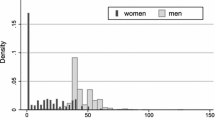Abstract
In this paper we use data on time allocation of women to estimate the value of market and non-market work. Four time use categories are distinguished: paid work, houshold work, care for children, and leisure. The estimation results show that the value of non-market production (household production and child care) is substantial and exceeds that of market production (paid work).
Similar content being viewed by others
REFERENCES
Blau, D. and M. Ferber, 1986, The Economics of Women, Men and Work, Englewood Cliffs, New Yersey, Prentice Hall.
Bruyn-Hundt, M., 1985, Household=Unpaid Labor: But Housewife's Wage is not the Solution ('Huishouden=onbetaalde arbeid: maar huisvrouwenloon geen oplossing), Deventer, Van Loghum Slaterus.
CBS, 1994, 'Time Allocation of Women and Men by Household Type' ('Tijdsbesteding van vrouwen en mannen naar huishoudenstype'), Sociaal-Culturele Berichten, 1994/20. pp. 3-32.
Flood, L. and A. Klevmarken, 1992, 'Market Work, Household Work and Leisure: An Analysis of Time Use in Sweden,' Paper for 22nd Conference of the International Association for Research in Income and Wealth, Flims, Switzerland.
Graham, J. and C. Green, 1984, 'Estimating the Parameters of a Household Production Function with Joint Products,' Review of Economics and Statistics, 66, pp. 277-282.
Gronau, R., 1980, 'Home Production-A Forgotten Industry,' Review of Economics and Statistics, 62, pp. 408-416.
Gronau, R., 1986, 'Home Production-A Survey,' in: O. Ashenfelter and R. Layard (eds.), Handbook of Labor Economics, Amsterdam, Elsevier SP, pp. 273-303.
Heckman, J., 1974, 'Shadow Prices, Market Wages and Labor Supply,' Econometrica, 42, pp. 679-694.
Homan, M., 1988, 'The Allocation of Time and Money in One-earner and Two-earner Families; An Economic Analysis,' PhD thesis, Erasmus University, Rotterdam.
Juster, T. and F. Stafford, 1991, 'The Allocation of Time: Empirical Findings, Behavioral Models, and Problems of Measurement,' Journal of Economic Literature, 29, pp. 471-522.
Kapteyn, A. and I. Woittiez, 1986, 'Labor Supply and the Formation of Preferences: An Exploratory Study on Dynamic Labor Supply' ('Arbeidsaanbod en voorkeursvorming: een verkennende studie naar de dynamiek in het gedrag van aanbieders van arbeid'), OSA-Werkdocument 23, The Hague.
Kerkhofs, M., 1994, 'A Quadratic Model of Home Production Decisions,' Discussion Paper TI94-45, Tinbergen Institute, Amsterdam/Rotterdam.
Kiker, B. and M. Mendes de Oliveira, 1992, 'Optimal Allocation of Time and Estimation of Market Wage Functions,' Journal of Human Resources, 27, pp. 445-471.
Killingsworth, M. and J. Heckman, 1986, 'Female Labor Supply, A Survey,' in: O. Ashenfelter and R. Layard (eds.), Handbook of Labor Economics, I, Amsterdam, North Holland, pp. 103-204.
Kooreman, P. 1987, 'The Effects of Taxes on the Choice between Market and Non-market Work,' Working Paper, Tilburg University.
Kooreman, P. and A. Kapteyn, 1987, 'A Disaggregated Analysis of the Allocation of Time within the Household,' Journal of Political Economy, 95, pp. 223-249.
Lippe, T. van der, 1992, 'The Distribution of Household and Paid Labor in The Netherlands' ('De verdeling van huishoudelijk en betaald werk in Nederland'), Mens en Maatschappij, 67, pp. 128-139.
Maassen van den Brink, H., 1994, Female Labor Supply, Child Care and Marital Conflict, Amsterdam, Amsterdam University Press.
Meijer, L., 1996, 'Mothers with Paid Work Spend Less Time on their Children' ('Moeder met baan besteedt minder tijd aan haar kinderen'), Demos, pp. 29-31.
Mincer, J. 1962, 'Labor Force Participation of Married Women: A Study of Labor Supply,' in: H. Gregg Lewis (ed.), Aspects of Labor Economics, New York, Princeton University Press.
SCP, 1992, 'Social-Cultural Report 1992' ('Sociaal-Cultureel rapport 1992'), Sociaal en Cultureel Planbureau, Rijswijk, The Netherlands.
Theeuwes, J. and I. Woittiez, 1992, 'Advising the Minister on the Elasticity of Labour Supply,' Research Memorandum 92.06, Department of Economics, Leiden University.
Author information
Authors and Affiliations
Rights and permissions
About this article
Cite this article
Maassen van den Brink, H., Groot, W. A household production model of paid labor, household work and child care. De Economist 145, 325–343 (1997). https://doi.org/10.1023/A:1003004126863
Issue Date:
DOI: https://doi.org/10.1023/A:1003004126863




